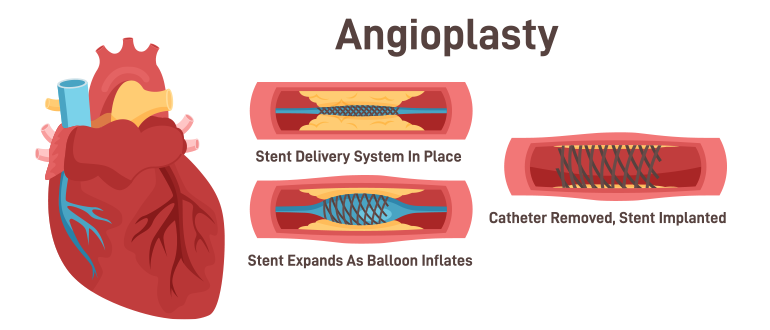Subscribe to get weekly insights
Always stay up to date with our newest articles sent direct to your inbox
Published on 24 Mar, 2023
Updated on 28 Aug, 2025
12602 Views
4 min Read

Written by Care Health Insurance
favorite1Like
Thanks to great technological advancements– breakthrough procedures are emerging to treat the world’s most chronic illnesses. Especially for the rising heart-related ailments, medical advancements are giving a solid ray of hope to patients worldwide. One of the most concerning cardiac conditions – heart blockage or coronary artery disease – is witnessing maximum successful treatment rates. Numbers prove that the two most critical heart surgeries – bypass and angioplasty – have a success rate of over 95% worldwide.
A procedure to cure heart blockage, angioplasty is a well-known procedure gaining attention recently among heart patients. This article elaborates on the angioplasty procedure and its risks, along with the right heart health insurance to cover this expensive procedure’s cost.
Angioplasty is a standard procedure to treat the accumulation of fatty and cholesterol deposits on the walls of the arteries– blocking the heart’s blood supply. The surgery clears up any blockage, clots or ruptures that may narrow the artery and hinder the proper flow of blood to the heart. Thus, angioplasty ensures normal heart rate and functioning by manually clearing up the heart deposit or clots. This is done with the help of a balloon or stent placement surgery, as elaborated further in the article.
This process of cholesterol deposits on the artery walls is called atherosclerosis, and the cholesterol buildup is called plaque. Several unhealthy factors form this blockage:
While the type and nature of artery blockage differ in every person, angioplasty becomes the first line of treatment to restore the heart's blood supply.
A cardiologist suggests immediate angioplasty when your heart’s blood vessels become intensely narrowed or hardened– causing a major or minor heart attack. While minor blockages are common among people, a blockage of more than 50%, along with the following symptoms, requires prompt angioplasty surgery:
Besides, doctors diagnose patients for atherosclerosis, angina or severe chest pain, and risk of coronary heart diseases before determining the treatment procedure.

While the angioplasty procedure may differ in every case depending on the heart’s condition, a standard angioplasty surgery follows the below steps:
Step 1: The surgeon prepares the patient by setting up the apparatus while giving the patient local anaesthesia.
Step 2: The doctor identifies the right wrist or groin to insert a tube or catheter into the artery. This is a plastic tube that helps doctors in threading the catheter into the blood vessels.
Step 3: With the help of fluoroscopy, the doctor directs the catheter towards the blocked artery through your blood vessels.
Step 4: After reaching the desired area, doctors inject a contrasting colour dye to see the narrowed artery more clearly.
Step 5: Once the narrowed artery is located, the doctors will inflate the balloon to unblock the plaque in the artery.
Step 6: Now is the time to place the stent in the right location of the blocked artery. A stent is a small tube-shaped metal mesh that keeps the plaque aside from blocking the blood flow.
Step 7: The last step is to deflate the balloon, pull out the catheter, and close the cuts or insertion points. The stent remains inside the heart’s arteries, helping in proper blood flow with the help of specific drug coatings.
After successfully completing the procedure, the patients are kept under observation for a day or two to keep a tab on their vitals. Doctors advise at least 6-8 hours of complete bed rest after the procedure. The precautions after angioplasty include minimal physical exertion, a healthy diet consumption, maintaining low-cholesterol and hypertension, and other healthy lifestyle habits.
Similar to any other medical surgery, angioplasty, too, involves certain health and medical risks, including:
To combat these risks, heart patients should consider asking the right question to their surgeon. For instance, what type of angioplasty is needed, allergic tests to be conducted, blood tests needed, and medications required, among other concerns.
In India, especially around metropolitan cities, the balloon angioplasty surgery cost lie between 1 lakh to 1.7 lakhs. The overall hospitalisation expenses during angioplasty are over 3 lakhs, which includes ICU rent, tests, doctor’s fees, and medications.
Also Read: 6 Most Common Types of Open Heart Surgery in India
At Care Health Insurance, we provide the most comprehensive heart mediclaim plan covering hospitalisation expenses related to major heart procedures and surgeries. The policy offers seamless coverage with the following benefits:
Care Heart Mediclaim offer a cashless and reimbursement facility for treating heart ailments at the top hospitals in India. The policy covers heart procedures like angioplasty, heart valve replacement, coronary artery bypass, pacemaker implantation, and others.
For people suspecting heart problems, the best way to secure your health and finances is by opting for the right heart health insurance policy. The best part about choosing Care Health Insurance is that we offer coverage against heart ailments to everyone– including existing heart patients. Yes, you can get health insurance after an angioplasty. Care Insurance also offers ‘Care Heart– The Heart Health Insurance for Heart Patients’ safeguarding existing heart patients against 16 major heart-related surgery expenses. Both of our heart insurance policies ensure optimum coverage to policyholders so they can lead a stress-free life for years to come.
Disclaimer: The medical advice and information are for reference purposes only. Kindly consult your doctor for accurate treatment advice. The policy benefits are subject to terms and conditions.
Thyroid : मामूली नहीं हैं महिलाओं में थायराइड होना, जानें इसके लक्षण और घरेलू उपचार Vipul Tiwary in Diseases
शुगर कंट्रोल कैसे करे? जानें, डायबिटीज में क्या खाना चाहिए Vipul Tiwary in Health & Wellness
हाई ब्लड प्रेशर को तुरंत कंट्रोल कैसे करें? देखें इसके उपाय Vipul Tiwary in Diseases
पैरों में दर्द किस कमी से होता है? जानें, इसके घरेलू इलाज Vipul Tiwary in Health Insurance Articles
Pacemaker Basics: Do You Need One? Leena Khowal in Heart
5 Shocking Reasons for Heart Attacks in Youth Jagriti Chakraborty in Heart
फिश ऑयल कैप्सूल के फायदे और नुकसान Vipul Tiwary in Home Remedies
Hole in Heart: Symptoms Causes and Treatments Riya Lohia in Diseases
Always stay up to date with our newest articles sent direct to your inbox
Loading...